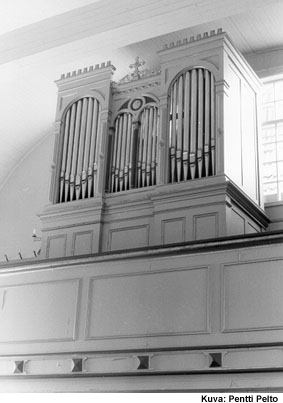|
HISTORICAL ORGANS IN FINLAND 
Halikko, Angelniemi- Zachariassen, Jens Alexander 1898
- 6 stops, 2 manuals and pedal
- mechanical action and mechanical stop action
Angelniemi Church was built by Matti Åkerblom. It was completed in 1774. It is a wood nave church with a pitched roof; along its sides are a porch and sacristy, and at the west end stands a belfry topped with an onion-shaped dome. The interior vault is also of wood.
Jens Alexander Zachariassen built a six-stop organ in Angelniemi Church in 1898. Although the pneumatic action was no longer a novelty at the time, Zachariassen chose to build a mechanical action here. A blower has been added to the organ, but it is otherwise unmodified.
Appearance
The organ is located in a loft at the west end of the church. The console is at the side of the instrument. The structure is simple: lowest in the organ case are the bellows, on top of which is the action, then the chest and finally the pipes.
The façade is divided into three arched flats, the middle one being sub-divided further into two separate flats. The middle section is lower and smaller than the flanking sections, which is rare. The middle section is topped with a cross, while the flanking sections have serrated mouldings. The sides of the organ case are frames; the case has a back wall, but no top. The façade pipes are for the most part speaking pipes. It is obvious that Zachariassen’s workshop used general style manuals common in the 19th century for the design of this façade, since it deviates clearly from the builder’s usual style. However, no clearly identifiable model has been found.
Technical features
The chest is of the stop channel type and functions pneumatically. The console is on the left side wall of the organ; it consists of two manual keyboards with celluloid and ebony coverings, and the pedalboard. The large lathe-turned wood stop knobs are above the keyboards, in the same order as the stops are on the chest. Both the action and the stop action are mechanical.
The reservoir is a double rise reservoir, and under its lower frame are two feeder bellows operated with a hand lever at the right side of the organ.
Musical properties
The touch is light and has no ‘pluck’ typical of a slider chest. Despite its high wind pressure, the organ has a soft and singing sound. However, it no longer has the intensity and edge of Zachariassen’s instruments of the 1870s and 1880s.
Zachariassen built a total of three six-stop organs with two manuals. Of these, the Angelniemi organ and the Velkua organ have been preserved. The disposition should be considered a single entity divided between two manuals. There is everything here that is needed to play the liturgical music current at the time of the instrument’s construction.
Disposition
Manual I C-f3 | Manual II C-f3 | Pedal C-d1 |
Principal 8’ | Gedacht 8’ | Subbas 16’ |
Dubbelflöjt 8’ | Salicional 8’ | |
Oktava 4’ | | |
| | |
| | |
| | |
| | |
| | |
| | |
| | |
| | |
| | |
| | |
|
|
|
II-I, I-Ped, II-Ped, I 4’ | | |
| | |
| | |
| | |
| | |
| | |
| | |
| | |
| | |
| | |
| | |
| | |
| | |
Further information
Pentti Pelto, Kaksi suomalaista urkuperinnettä (dissertation), Vammala 1994.
|